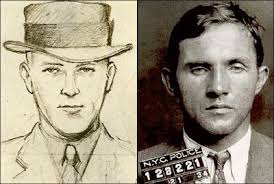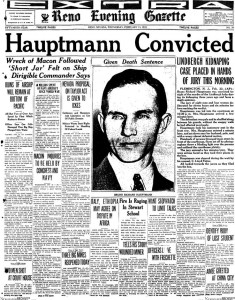
Article in the New York Times on the Charles Lindburg Jr. Kidnapping Source:http:// images.rarenewspapers.com/ebayimgs/ 1.93.2012/image012.jpg
Charles Lindbergh Jr. was kidnapped on the evening of April 3, 1936. He was taken from his crib in the Lindberg’s beautiful home in Hopewell, New Jersey. What would ensue afterwards would be one of the most bizarre stories that crime journalists have ever reported. Initially after the kidnapping, the New Jersey state police took over the investigation. Additionally, Lindberg led the investigation, beginning negotiations with Lindberg Jr.’s kidnapper. Lindberg’s lead in the investigation was immediately made public, and it mad the community question the reliability of the police. The investigative team used a retired Bronx schoolteacher by the name of Dr. John F. Condon to communicate with the kidnapper. Dr. Condon would begin these negotiations with the perpetrator under the alias “Jafsie”. The perpetrator went by “John”. Dr. Condon met with John three times in a New Jersey cemetery. In the last meeting, a ransom note was given in exchange for Lindberg Jr. Instead of receiving Lindberg, “John” handed over a note stating that Lindberg Jr. was on a small boat along the coast of Massachussetts. This boat was never found. A month later, the body of Lindberg Jr. was found four miles away from the Lindberg estate. The body had a significant blow to the head, and the cause of death was determined to be homicide.

Comaprison of a sketch of “John” to a photo of Hauptmann Source: http://www.crimemuseum.org/wp-content /uploads/2014/08/ hauptmann.jpg
An interesting break would take place in 1933 when the president issued an executive order declaring that all gold certificates be returned to the treasury. A significant portion of the monies given to “John” were gold certificates. Additionally, the serial numbers of the certificates given to “John” were recorded. Pamphlets were given to banks throughout the region that listed the serial numbers. The New York Bureau was alerted to a $10 gold certificate bearing one of Lindberg’s serial numbers. The certificate was tracked to a gas station. Investigators discovered that the gas attendant had written down the license plate number of a man who had given him the gold certificate. The license plate number was tracked to a man named Richard Hauptmann. After searching his home, police found $14,000 of the Lindberg money. Richard Hauptmann was taken to trial and found guilty of first degree murder. To the press, Hauptmann’s trial was a critical trial to cover. A kidnapping amongst such a prestigous family warranted extra attention. Hundreds of papers throughout the country bore the news of the trial on the front page. Hauptmann was sentenced to death. On April 3, 1936, Hauptmann was put to death. Despite the tremendous evidence against Hauptmann, the case still begs to question whether or not Hauptmann actually committed the crime. Also, how did the press cover this “crime of the century”? What made this case bizarre? Perhaps a long line of false suspects and bizarre twists.

Paper displaying the conviction of Hauptmann Source: <a href="https://s-mediacacheak0.pinimg.com/736x/25/56/ca/ 2556ca13f51551523b343a33b522c212.jpg
“>https://s-mediacacheak0.pinimg.com/736x /25/56/ca/2556ca13f51551523b343a33 b522c212.jpg
Violet Sharpe, the waitress for Mrs. Lindberg’s mothers home, was questioned throughout the investigation. According to the Charles Lindberg website, Violet Sharpe committed suicide by taking a poison pill prior to re-questioning. What is more bizarre is the fact that she had nothing to do with the crime, and upon further investigation, all of her whereabouts were accounted for throughout the night of the abduction. In addition to this bizarre suicide, investigators exhausted thousands of leads throughout the United States. One group in particular, the “Purple Gang” of Detroit was investigated thoroughly. Boat registries throughout the United States were inspected for “Nellie”, the alleged name of a boat on which the Lindberg’s were told the child had been taken.
One particularly significant lead was Gaston B. Means. He had previously been approached by an investigator named Evalyn McLean. Means had informed her that prior to the kidnapping, Means had been informed of an important kidnapping taking place. Means declined to join in the endeavor. He additionally claimed that his friend had committed the kidnapping. Mrs. McLean gave $100,000 to Means in order to retreive the child. Mclean conducted daily updates with Means on the investigation and his communications with the alleged perpetrator, named “The Fox”. After a month of no results, McLean contacted the FBI. Means and a another man named Norman T. Whitaker were arrested for embezzlement and fraud. They really had no information on the whereabouts of Charles Lindburg Jr.

Leave a response